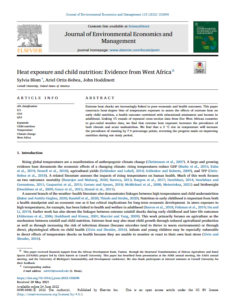
Abstract
Extreme heat shocks are increasingly linked to poor economic and health outcomes. This paper constructs hour-degree bins of temperature exposure to assess the effects of extreme heat on early child nutrition, a health outcome correlated with educational attainment and income in adulthood. Linking 15 rounds of repeated cross-section data from five West African countries to geo-coded weather data, we find that extreme heat exposure increases the prevalence of both chronic and acute malnutrition. We find that a 2 °C rise in temperature will increase the prevalence of stunting by 7.4 percentage points, reversing the progress made on improving nutrition during our study period.
Introduction
This paper estimates the cumulative effects of heat on child nutrition. We construct precise measures of heat exposure by calculating hour-degree bins of exposure to extreme heat. We use this measure to test the hypothesis that lifetime heat exposure negatively affects chronic nutrition as measured by height-for-age z-scores (HAZ) and recent heat exposure negatively affects acute nutrition as measured by weight-for-height z-scores (WHZ). We test these hypotheses in the West African context linking data collected by the Demographic and Health Surveys (DHS) Program in Benin, Burkina Faso, Côte d’Ivoire, Ghana, and Togo between 1993 and 2014 with a gridded weather dataset from the Princeton Terrestrial Hydrology Research Group. We interact local fixed effects with interview month and year to control for both seasonality and annual trends at the local level. This leaves us with temporal variation stemming from differences in children’s dates of birth to identify effects on HAZ and a combination of within-region and within-month, inter-annual variation to identify effects on WHZ.
We focus on children aged 3–36 months, an understudied group in the weather–health literature. Much of the prior work focuses on the effects of heat exposure in utero but less is known about the postnatal, preschool age group and, within this age group, precisely when children are most vulnerable to heat shocks. Our approach deviates from the existing weather–nutrition work to-date, which primarily uses mean monthly temperatures or deviations in annual temperature to measure heat shocks and is designed to capture agriculture-related effects of heat exposure. While our approach might underestimate the agricultural channel because it treats heat during the growing season the same as heat during other seasons, we expect that it will better capture effects through alternate channels, such as illness. This choice was motivated by the relative scarcity of weather–health literature examining channels other than agriculture. By examining heat exposure in this way, we hope to gain a more comprehensive understanding of the risks of extreme heat to child nutrition.